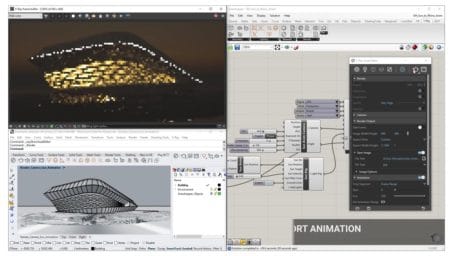Chaos Group has announced the all-new V-Ray Next for Rhino, a culmination of four years of research and development and changes to what designers can do with Rhino and Grasshopper.
Importantly, V-Ray Next for Rhino enables live interactivity in Grasshopper, bringing algorithmic design work to life with new photorealistic rendering for stills and animations.
What’s In V-Ray Next for Rhino (and Grasshopper!)
Tailored tools have expanded the core capabilities of Rhino and Grasshopper, linking photorealistic rendering, scene intelligence, and asset management into a powerful new workflow that centralizes the design/visualization experience.

01 – V-Ray Next for Rhino offers dozens of new features for advanced visualization from Rhino and Grasshopper generated models.
“V-Ray Next for Rhino turns four years of R&D into a mechanism of change, fixing issues that used to cost designers a lot of time and energy,” said Konstantin Gaytandzhiev, Product Specialist for Rhino at Chaos Group. “As we continue to roll out new features, we’ll continue this journey, making V-Ray Next faster, smarter and more in tune with how people actually want to work.”
New Features in V-Ray Next for Rhino
There are multiple new powerful new features and improvements in V-Ray Next for Rhino. Here is a brief run-down.
Render Faster
V-Ray Next is faster everywhere you look. Thanks to the optimized materials and overall performance gains in V-Ray Next, rendering speeds are now up to 50 percent faster than before. Improvements to GPU rendering offer another 200 percent, further extended through V-Ray Scene Intelligence, which can show specific improvements up to 7x.
Render Smarter
V-Ray Scene Intelligence, introduced in V-Ray Next, automatically analyzes a 3D scene at the start of a render to optimize some of the most common decisions a designer will make. For instance, the new Adaptive Dome Light (ADL) now offers more accurate, image-based environment lighting that’s up to 7x faster. This is especially helpful for interiors, where it removes the need to add separate light portals at windows and openings.
V-Ray Scene Intelligence has also improved the V-Ray camera, which can now set exposure and white balance automatically, allowing for picture-perfect renders every time. No-input denoising is also available through the new NVIDIA AI denoiser, which eliminates image noise almost instantly, giving an immediate sense of lighting. This type of denoising is perfect for interactively fine-tuning the look of a scene.
Powerful Asset Management
The new asset management system acts as a new project control center, helping designers streamline workflows and coordinate across projects. Now, designers can manage all of their V-Ray scene assets in an intuitive way, using the live preview function to fine-tune the look of lights, textures and materials from a central location.
Unparalleled Grasshopper Support
V-Ray Next for Rhino launches with the most comprehensive Grasshopper toolset on the market, bringing new abilities to the parametric design tool. With live interactivity, designers can use V-Ray from within Grasshopper to produce stunning visualizations of abstract curves and repeating patterns, without exporting anything back to Rhino. Users can also now animate sunlight, cameras and Grasshopper definitions from the V-Ray timeline. Definitions stay parametric throughout the rendering process, in both Grasshopper and Rhino.
Additional features include:
- Enhanced GPU Rendering — Designers can now access the full power of GPU rendering in V-Ray, adding support for bucket rendering, volumetric effects such as smoke and fog, and compatibility with VRscans, Chaos Group’s library of physically accurate, scanned materials.
- More Accurate Viewport Previews — Improved accuracy in the Rhino viewport with enhanced reflections, refractions, bump maps and more.
- Automated Rendering with V-Ray Batch — With access to V-Ray Swarm, it’s now easier to render snapshots and variations of a project, as well as views from multiple Rhino files.
- New Lighting Analysis Tool — Visualize a scene’s real-world illumination values (lux) using the new lighting analysis render element.
- New Scripting Tool — Use RhinoScript or Python to automate V-Ray tasks and properties, or access V-Ray capabilities not present in the UI.
“V-Ray Next for Rhino is, without a doubt, the most amazing leap forward in the history of V-Ray for Rhino,” said Polyhedra co-founders Federico Fernandez and Andrea Montis. “We’re finally able to edit everything without relying on other 3D applications or leaving the software. And these speed boosts are making our dreams come true!”
For a full list of new features, please visit: chaosgroup.com.
Pricing and Availability
V-Ray Next for Rhino is available now and is compatible with Rhino 5-6. A full Workstation license is priced at $790, with upgrades available for $395. Annual licenses are available as well for $350 per year. For a free 30-day trial, click here.
About Chaos Group
Chaos Group is a worldwide leader in computer graphics technology, helping artists and designers create photorealistic imagery and animation for architecture, design, and visual effects. Chaos Group’s award-winning physically-based rendering and simulation software is used daily by top design studios, architectural firms, advertising agencies, and visual effects companies around the globe. Today, the company’s research and development in ray-traced rendering, cloud computing and real-time ray tracing is shaping the future of creative storytelling and digital design. Founded in 1997, Chaos Group is privately owned with offices in Sofia, Los Angeles, Prague, Seoul, and Tokyo. For more information, visit: chaosgroup.com.




Reader Comments
Comments for this story are closed